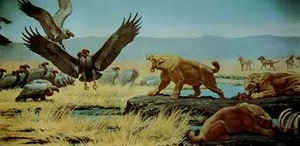
Oklahoma Symbols
Oklahoma State Fossil
Theropod Dinosaur

(Saurophaganax maximus)
Adopted on April 14, 2000.
The governor signed Senate Bill 1185 on April 14, 2000 designating the Theropod Dinosaur, (Saurophaganax maximus,) the state fossil.
This spectacular dinosaur, the "greatest king of reptile eaters", once roamed this great land. It is only known from Oklahoma and has surpassed the Tyrannosaurus rex, the "king of the dinosaurs", as the greatest predator of earth's history. The first bones of Saurophaganax were found in the late 1930s by a WPA crew under the supervision of a University of Oklahoma paleontologist. Since that time, discoveries have been rare and fragmentary. However, a very nice restoration is on display at the Sam Noble Museum in Norman, which has an entire hall devoted to prehistoric life.
Oklahoma State Fossil: Theropod Dinosaur

Saurophaganax ("lizard-eating master") is a genus of allosaurid dinosaur from the Morrison Formation of Late Jurassic Oklahoma (latest Kimmeridgian age, about 151 million years ago). Some paleontologists consider it to be a species of Allosaurus (A. maximus). Saurophaganax represents a very large Morrison allosaurid characterized by horizontal laminae at the bases of the dorsal neural spines above the transverse processes, and "meat-chopper" chevrons.The maximum size of S. maximus has been estimated at anywhere from 34 ft to 43 ft in length, and around 3 ton in weight.
Characteristics of the Theropod Dinosaur

The theropod (meaning "beast-footed") dinosaurs are a diverse group of bipedal saurischian dinosaurs. They include the largest terrestrial carnivores ever to have made the earth tremble.
Geologic Time: 145 to 150 million years ago (Late Jurassic)
Geographic Range: Wyoming, Montana, Colorado, New Mexico, South Dakota, Utah, and Oklahoma
Identification: Allosaurus was the most common large carnivore of the Late Jurassic in North America. It was a smaller predecessor of the Cretaceous Tyrannosaurus. Strong forelimbs with sharp claws, powerful hind legs and recurved, dagger-like teeth are evidence that Allosaurus was a formidable predator. Although it was much smaller than sauropods like Apatosaurus (Brontosaurus), which were also common at the time, quite possibly Allosaurus hunted in packs to bring down larger prey. Like many meat eaters, it may also have been a scavenger.
Many Allosaurus specimens representing individuals of different ages have been recovered in exposures of the Morrison Formation in the Rocky Mountain West. This specimen is interpreted as a subadult.
Adult Weight: 1.5 - 2 tons
Adult Length: 30 - 40 ft long
Habitat: Plains and lowlands
Diet: Meat
Several characteristics that typify a theropod:
- They were all carnivores (meat-eaters)
- Most theropods had sharp, recurved teeth useful for eating flesh, and claws were present on the ends of all of the fingers and toes. - - They all used their back legs for walking and each foot had three toes
- The fourth and fifth digits are reduced;
- Most walked exclusively on two legs
- They had hollow limb bones
- The humerus (upper arm bone) is less than half as long as the femur (upper leg bone)
Oklahoma Law
The law designating the mistletoe as the official Oklahoma state floral emblem is found in the Oklahoma Statutes, Title 25, Chapter 3 Section 25-98.6
Title 25. Definitions and General Provisions.
Chapter 3 - State Emblems and Honorary Positions.
SECTION 25-98.6
§25-98.6. State fossil.
Because of the extraordinarily rich paleontological heritage of the State of Oklahoma, the Legislature hereby declares Saurophaganax Maximus to be
the State Fossil of Oklahoma. This spectacular dinosaur, the "greatest king of reptile eaters", once roamed this great land. It is only known
from Oklahoma and has surpassed the Tyrannosaurus rex, the "king of the dinosaurs", as the greatest predator of earth's history.
Added by Laws 2000, c. 72, § 1, emerg. eff. April 14, 2000.
Taxonomic Hierarchy: Theropod Dinosaur
Kingdom: Animalia
Phylum: Chordata
Order: Saurischia
Suborder: Theropoda
Clade: †Carnosauria
Clade: †Allosauria
Family: †Allosauridae
Genus: †Saurophaganax Chure, 1995
Species: † S. maximus
Binomial name: Saurophaganax maximus (Stovall, 1950)
Synonyms:
"Saurophagus" maximus Stovall, 1950 (preoccupied)
Allosaurus maximus (Stovall, 1950)

Some states that lack a "state fossil" have nevertheless singled out a fossil for formal designation such as a state dinosaur, rock, gem or stone.






